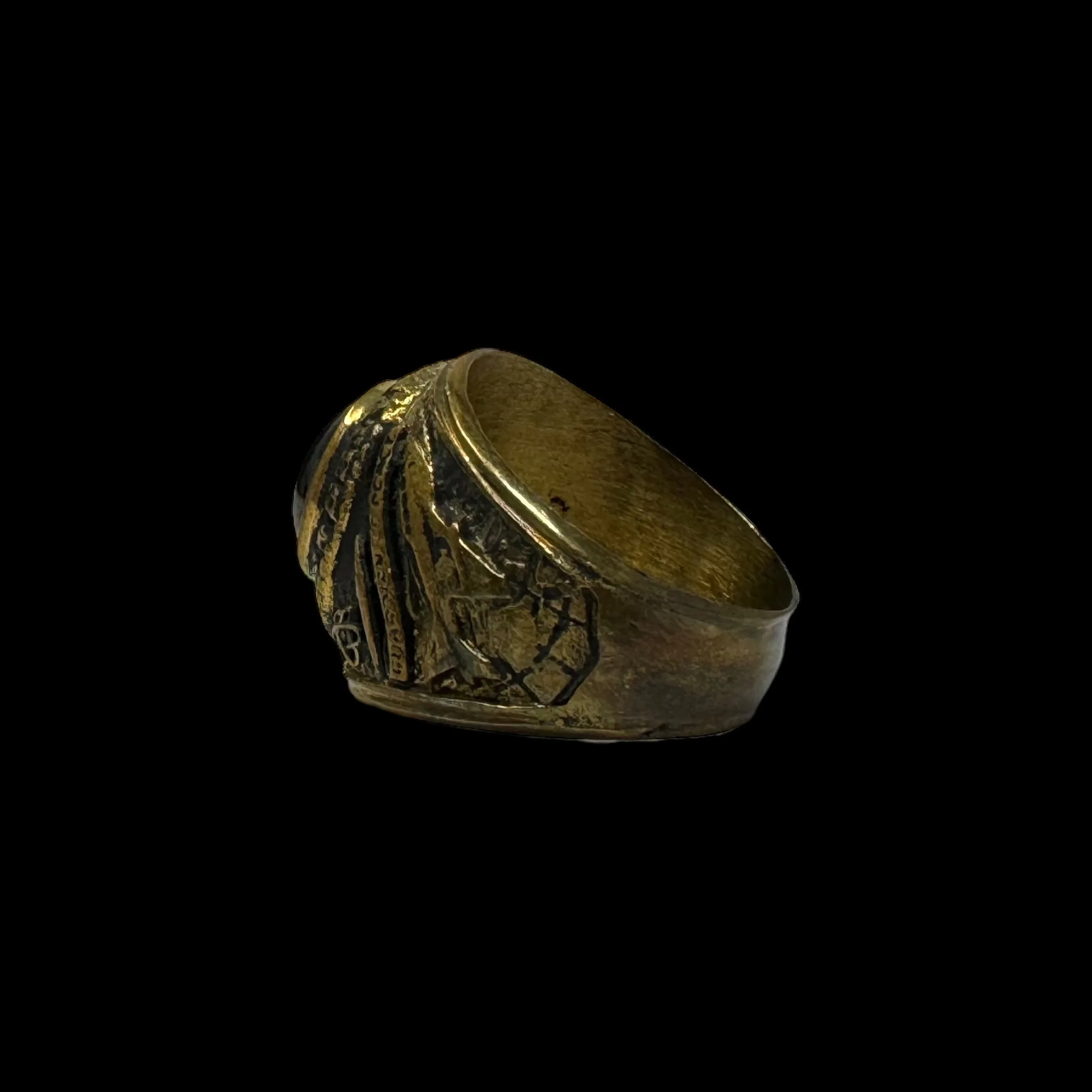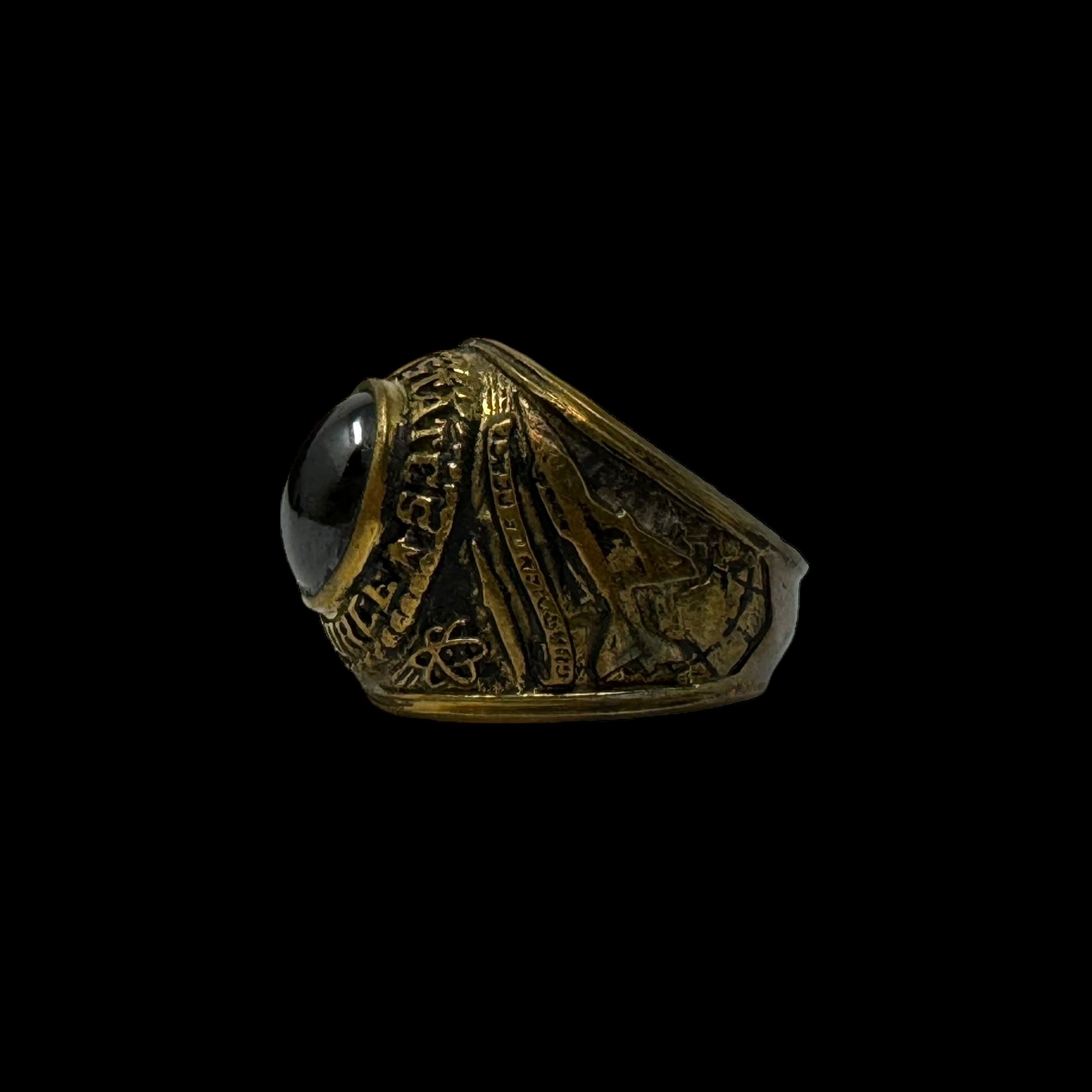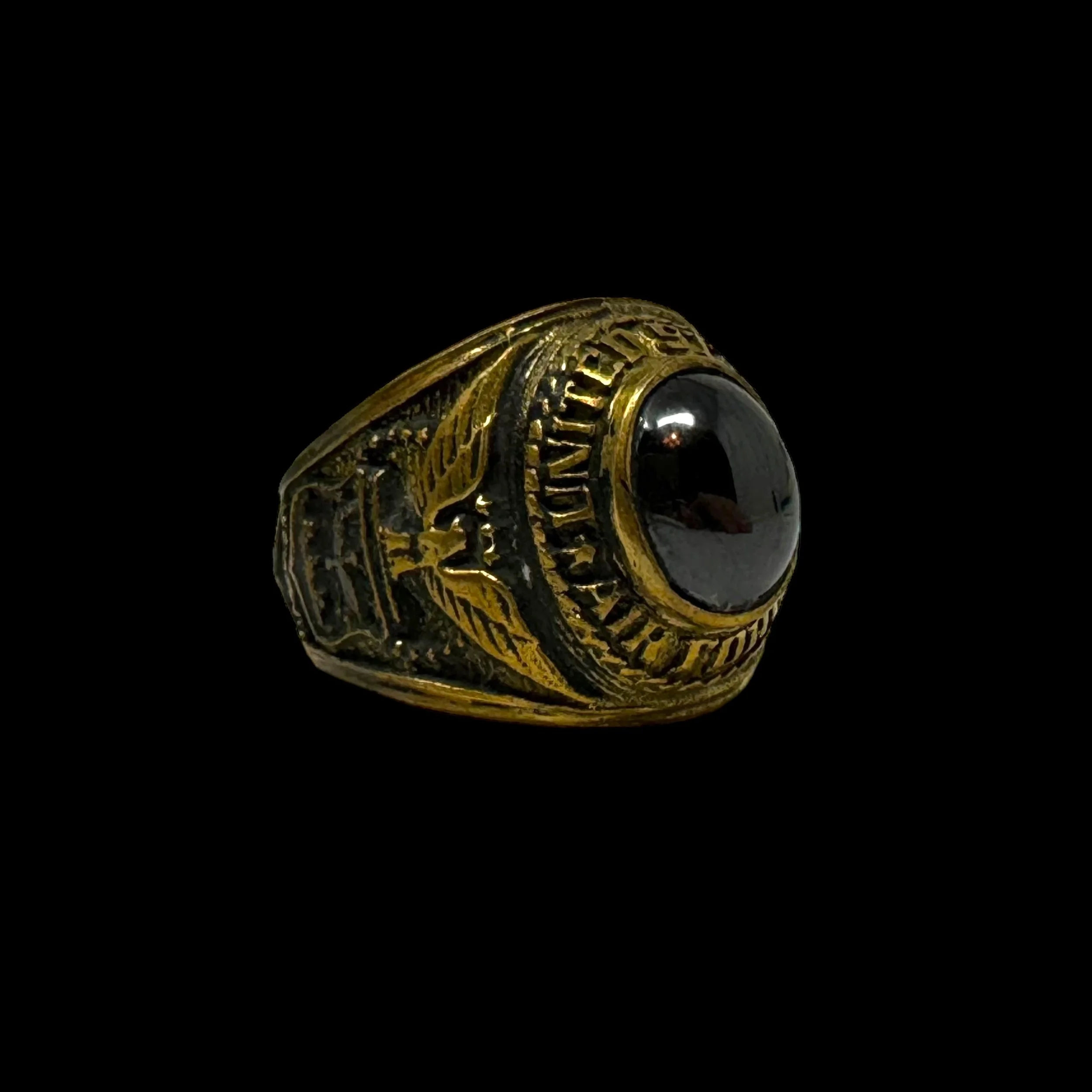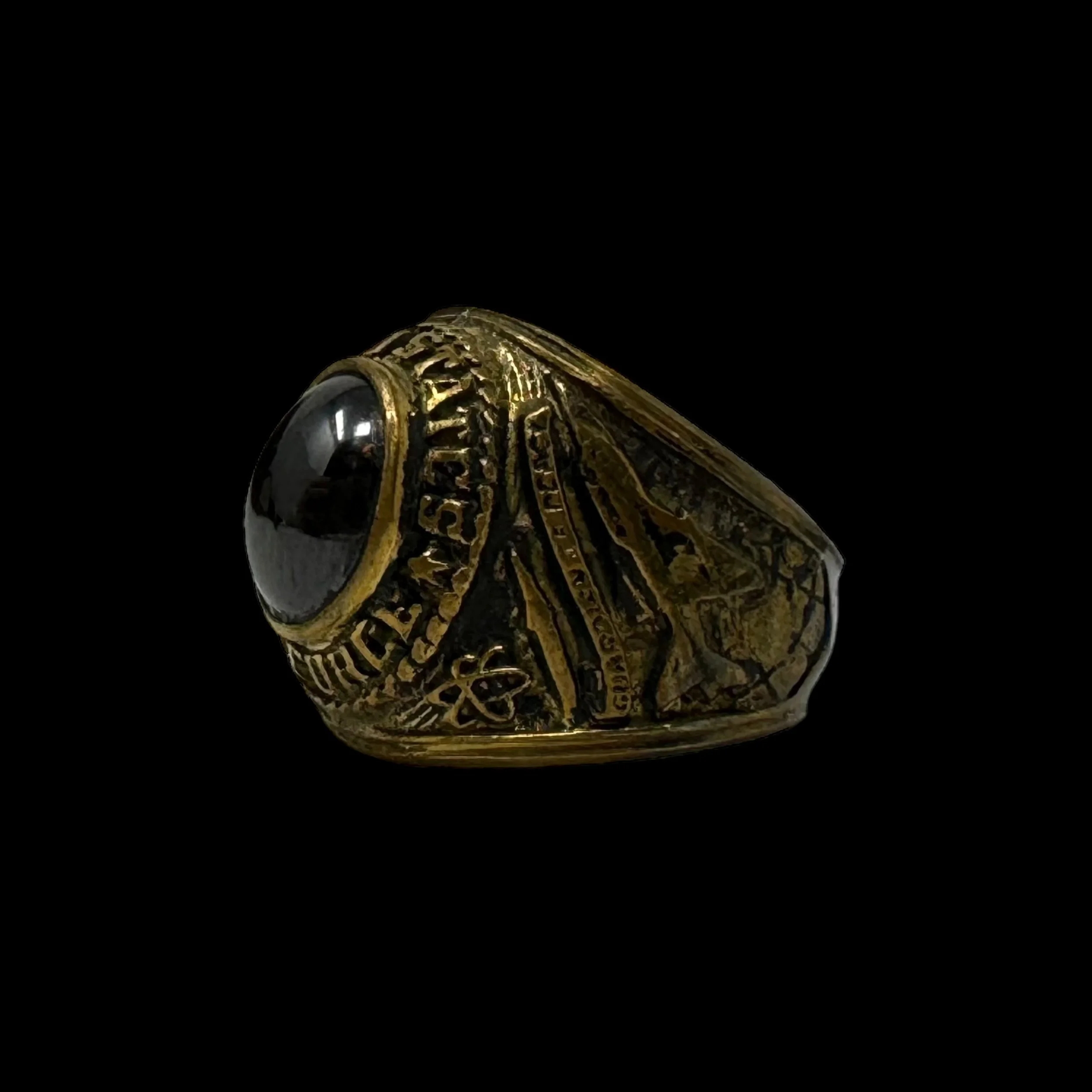Vietnam War U.S. Air Force U.S. Pilot's "10K GOLD" Black Gemstone Ring
















Vietnam War U.S. Air Force U.S. Pilot's "10K GOLD" Black Gemstone Ring
Comes with a hand-signed C.O.A.
*Thanks to the overwhelming demand for our authentic "Wearable History Collection" we are delighted to introduce one of our inaugural "Wearable History Exclusives." This remarkable historical ring is an authentic, era-original ring, characterized by its robust, unaltered condition, making it entirely suitable for contemporary wear even today. This ring, from our "Wearable History Collection," stands as a distinctive and invaluable addition to the collection of any history enthusiast.
This original and museum-grade Vietnam War artifact is a very rare and historic ring presented and worn by a decorated Vietnam War U.S. Air Force pilot. United States Air Force. All told, the U.S. Air Force flew 5.25 million sorties over South Vietnam, North Vietnam, northern and southern Laos, and Cambodia, losing 2,251 aircraft: 1,737 to hostile action, and 514 in accidents. 2,197 of the losses were fixed-wing, and the remainder rotary-wing.
This Vietnam War U.S. Air Force pilot ring is made from a beautiful 10K GOLD with an eerie dark black gemstone.
This original WWII Vietnam War silver ring not only serves as a wonderful piece of history but also something that a history buff can wear or display. This is also a fantastic piece to wear in remembrance and honor of the men who served with one of the most infamous divisions during the Vietnam War.
The Vietnam War, spanning from 1955 to 1975, stands as a significant chapter in the annals of military aviation history, showcasing the evolution of air warfare and the pivotal role of the U.S. Air Force (USAF) in modern conflict. The war marked a period of intense aerial combat operations, strategic bombings, and the development and deployment of advanced aircraft technologies.
Initial Involvement and Escalation
The early involvement of the USAF in Vietnam was characterized by a limited advisory role, supporting the South Vietnamese with training and reconnaissance missions. However, the Gulf of Tonkin Incident in August 1964 marked a pivotal moment, leading to a significant escalation of U.S. military involvement. President Lyndon B. Johnson authorized Operation Rolling Thunder in March 1965, a sustained bombing campaign against North Vietnam, which significantly expanded the USAF's role in the conflict.
Strategic Bombing Campaigns
Operation Rolling Thunder was the first major aerial bombardment campaign conducted by the USAF in North Vietnam. Its primary objectives were to destroy North Vietnam's transportation systems, industrial base, and air defenses, thereby reducing its capacity to support Viet Cong operations in the South. The operation saw the deployment of several aircraft types, including the F-105 Thunderchief, known affectionately as the "Thud." Despite its vulnerability to anti-aircraft fire and surface-to-air missiles (SAMs), the F-105 carried out the majority of strike bombing missions during the early years of the conflict.
As the war progressed, the USAF introduced the F-4 Phantom II, a versatile and powerful aircraft that served in various roles, including air superiority, ground attack, and reconnaissance missions. The Phantom II became one of the most important aircraft in the USAF inventory, known for its speed, payload, and advanced radar and weapons systems, which allowed it to dominate aerial engagements against North Vietnamese MiGs.
The B-52 Stratofortress, a long-range, subsonic, jet-powered strategic bomber, played a crucial role in Operation Arc Light and later in Operation Linebacker I and II. These operations involved high-altitude carpet bombing of North Vietnamese targets, including military installations, industrial facilities, and logistics networks. The B-52s were instrumental in the Christmas Bombings of 1972, a massive bombing campaign that aimed to force North Vietnam back to the negotiating table, ultimately contributing to the signing of the Paris Peace Accords in January 1973.
Close Air Support and Interdiction
Beyond strategic bombing, the USAF was heavily involved in close air support (CAS) and interdiction missions to aid ground troops and disrupt enemy supply lines. Aircraft such as the A-1 Skyraider, an older propeller-driven plane, were revered for their durability and payload capacity, proving effective in CAS roles. The A-7 Corsair II and the F-100 Super Sabre were also utilized for ground-attack missions, providing crucial support to U.S. and South Vietnamese ground forces.
The AC-130 gunship, a heavily armed ground-attack variant of the C-130 Hercules transport aircraft, was introduced during the Vietnam War. Equipped with side-firing weapons integrated with sophisticated sensor and fire-control systems, the AC-130 was capable of delivering precision fire support during night operations and in adverse weather conditions, particularly along the Ho Chi Minh Trail.
Reconnaissance and Electronic Warfare
Reconnaissance missions were vital for gathering intelligence on enemy movements, assessing bomb damage, and identifying SAM sites. The RF-101 Voodoo and the SR-71 Blackbird were among the key aircraft used for high-speed, high-altitude reconnaissance missions over North Vietnam. The SR-71, in particular, known for its incredible speed and altitude capabilities, was able to conduct reconnaissance missions with relative impunity, despite attempts by North Vietnamese defenses to intercept it.
Electronic warfare also emerged as a critical component of air operations, with aircraft like the EB-66 Destroyer and the EC-121 Warning Star playing essential roles in jamming enemy radar and providing early warning of enemy air defenses and missile launches to strike packages.
Challenges and Adaptations
The Vietnam War posed significant challenges to the USAF, including the threat of SAMs and the limitations of conducting operations over jungle-covered terrain, which often concealed enemy movements. The introduction of SAMs by the Soviet Union forced the USAF to develop new tactics and technologies, including the deployment of "Wild Weasel" missions aimed at suppressing and destroying North Vietnamese air defenses.
The Vietnam War underscored the importance of air power in modern warfare, highlighting both its capabilities and limitations. The missions flown by USAF pilots over Vietnam were diverse, ranging from strategic bombing and close air support to reconnaissance and electronic warfare, each requiring different aircraft and tactics. The war accelerated advancements in aviation technology and tactics, leaving a lasting impact on U.S. military doctrine and the development of air power. While the conflict in Vietnam ended without a clear victory for the United States, the lessons learned and the valor demonstrated by the pilots and aircrews of the USAF have continued to shape the future of aerial combat and military strategy.